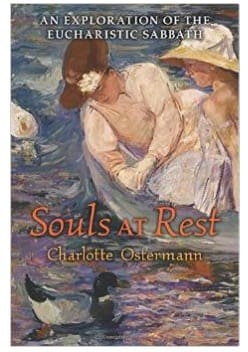 Note from Dan: Rarely will you find a soul yielded to God who does not also experience a great deal of peace. These souls often have one thing in common, their faith is revealed in the way they live. They recognize that God is their provider and thus honor Him as such – with rest. If you have less peace than you would like to admit, more anxiety than you would like to have, maybe it is time to return to God’s provision for a simple path to peace – a path that begins every week anew with the sabbath. I know of no better treatment of the subject than the one we recommend here. Charlotte Ostermann has given a gift to us in revealing the wisdom of God’s call to rest. If you heed the call, you will begin a path of peace that will draw you ever more deeply into the heart of God and the “abundant life” promised and offered through Christ.
Note from Dan: Rarely will you find a soul yielded to God who does not also experience a great deal of peace. These souls often have one thing in common, their faith is revealed in the way they live. They recognize that God is their provider and thus honor Him as such – with rest. If you have less peace than you would like to admit, more anxiety than you would like to have, maybe it is time to return to God’s provision for a simple path to peace – a path that begins every week anew with the sabbath. I know of no better treatment of the subject than the one we recommend here. Charlotte Ostermann has given a gift to us in revealing the wisdom of God’s call to rest. If you heed the call, you will begin a path of peace that will draw you ever more deeply into the heart of God and the “abundant life” promised and offered through Christ.
 Editor’s Note: Today we welcome Charlotte Ostermann to our writing team. Charlotte is a convert, an educator, poet, singer, speaker, and retreat designer. In addition to the books she has written (which you can see in her bio below), she has also been widely published in a number of different periodicals (also listed in her bio). Her book about the Sabbath rest, Souls at Rest: An Exploration of the Eucharistic Sabbath just came out in December! She is a member of and spiritual mentor with the Family of the Apostles of the Interior Life, in Kansas City, Kansas. We are blessed that she has joined our writing team. Please make her feel at home.
Editor’s Note: Today we welcome Charlotte Ostermann to our writing team. Charlotte is a convert, an educator, poet, singer, speaker, and retreat designer. In addition to the books she has written (which you can see in her bio below), she has also been widely published in a number of different periodicals (also listed in her bio). Her book about the Sabbath rest, Souls at Rest: An Exploration of the Eucharistic Sabbath just came out in December! She is a member of and spiritual mentor with the Family of the Apostles of the Interior Life, in Kansas City, Kansas. We are blessed that she has joined our writing team. Please make her feel at home.
So, without further ado, Here is the question Charlotte answers for us today:
I’m feeling burnt out and a bit lifeless spiritually. I’m living in a state of grace. I’m a committed Catholic. I don’t know what else to do to revitalize my spiritual life. Can you help?
That lifeless feeling you describe may be what our Church fathers called ‘acedia’. Burnt out, spent, listless, going through the motions, flat – all speak of that same condition. What you need is profound, healing, spiritual rest. The rest that is to be found in Christ, and that makes us more fully alive is ‘holy leisure’.
What does holy leisure look like? Only you can fully answer that question, but I can give you some guidelines.
- Holy Leisure is Eucharistic
In the Blessed Sacrament, God gives us perfect nourishment for the spiritual life. The problem is that we are not perfectly able to receive, to appropriate, all the goodness we are given. As you consider how to provide for the healing rest your soul needs, keep your focus on the essential component: the Real Presence of Christ.
- Holy Leisure Begins with the Sabbath
Sabbath-keeping wasn’t abolished by the coming of the Messiah, but fulfilled. Our Eucharistic, Sunday Sabbath is a fountain of refreshment, the source of the deep rest your soul craves. As you consider what you need to do, or not do, to keep the Sabbath day holy, you’ll be designing a ‘setting’ for the ‘jewel’: the Blessed Sacrament.
Holy leisure will begin to permeate your whole life, if you let your soul enter into it fully on Sundays. Sunday is the place to begin learning how to sanctify every day. Have you ever noticed that ‘any time’ is ‘no time’? God, in His wisdom, taught His people to set apart a day and place careful boundaries around it so as to protect a sacred encounter. St. Pope John Paul reminded us not to live ‘for the weekend,’ but to cultivate true Sabbath-centered, holy leisure.
- Holy Leisure is a Tonic Remedy
For some people, ‘acedia’ starts with laziness. Their spiritual torpor, or sloth, is rooted in the lack of activity, firm intention, virtue and hard work of day-to-day life. For others, the same inability to move themselves toward spiritual goods, or to approach the spiritual life with zeal, is caused by their constant busy-ness, distraction from self-examination and goal-oriented doing. For one, keeping the Sabbath holy – sacred, set apart for Christ – may mean taking up actions that provide spiritual discipline, serve others, bring them into community and exercise the will. For the other, the Sabbath day may need to be a space carved out of activity for non-doing, contemplation, quiet and solitude.
As a tonic medicine restores the body to a balanced, healthy ‘tone,’ a holy, Eucharistic Sabbath day restores and refreshes your whole being when it counteracts the particular imbalances of the rest of your week. Think of yourself as a stringed instrument. Are your strings too slack, or too tight to play beautiful music?
- Holy Leisure Leads to Interior Freedom
By continuing to live a sacramental, Catholic life, in a state of grace, you have nurtured and sustained the life of Christ within your own being. You have already begun to move toward greater vitality and fullness of life by identifying your need for something more, and asking for help. Now, by considering how to design the Sabbath day that corresponds to your own personal ways of getting ‘unstrung,’ you are engaging self-awareness, creativity and free will. The result – growing interior freedom – is the opposite of the acedia that weighs down and casts a gloomy cloud over your life in Christ.
I hope you’ll enjoy this approach to designing your sacred Sabbath, and grow more deeply rested, more free and joyful, each week.
+
Art: Charlotte Ostermann and book cover used with permission, all rights reserved.





